Vegan Scottish Skirlie, otherwise known as 'poor-mans haggis', is a tasty, nutritious, economical dish. Skirlie is especially satisfying served with mashed neeps and tatties (potatoes and turnip) and lashings of veggie gravy. Pinhead oatmeal is quickly cooked with diced onion, herbs, and nutritional yeast for a flavourful nutty texture. Skirlie is ideal for an inexpensive quick vegetarian or vegan haggis replacement to enjoy on Hogmanay, Robert Burns Supper, or just as a tasty vegan oatmeal side dish along with your favourite soups and stews.
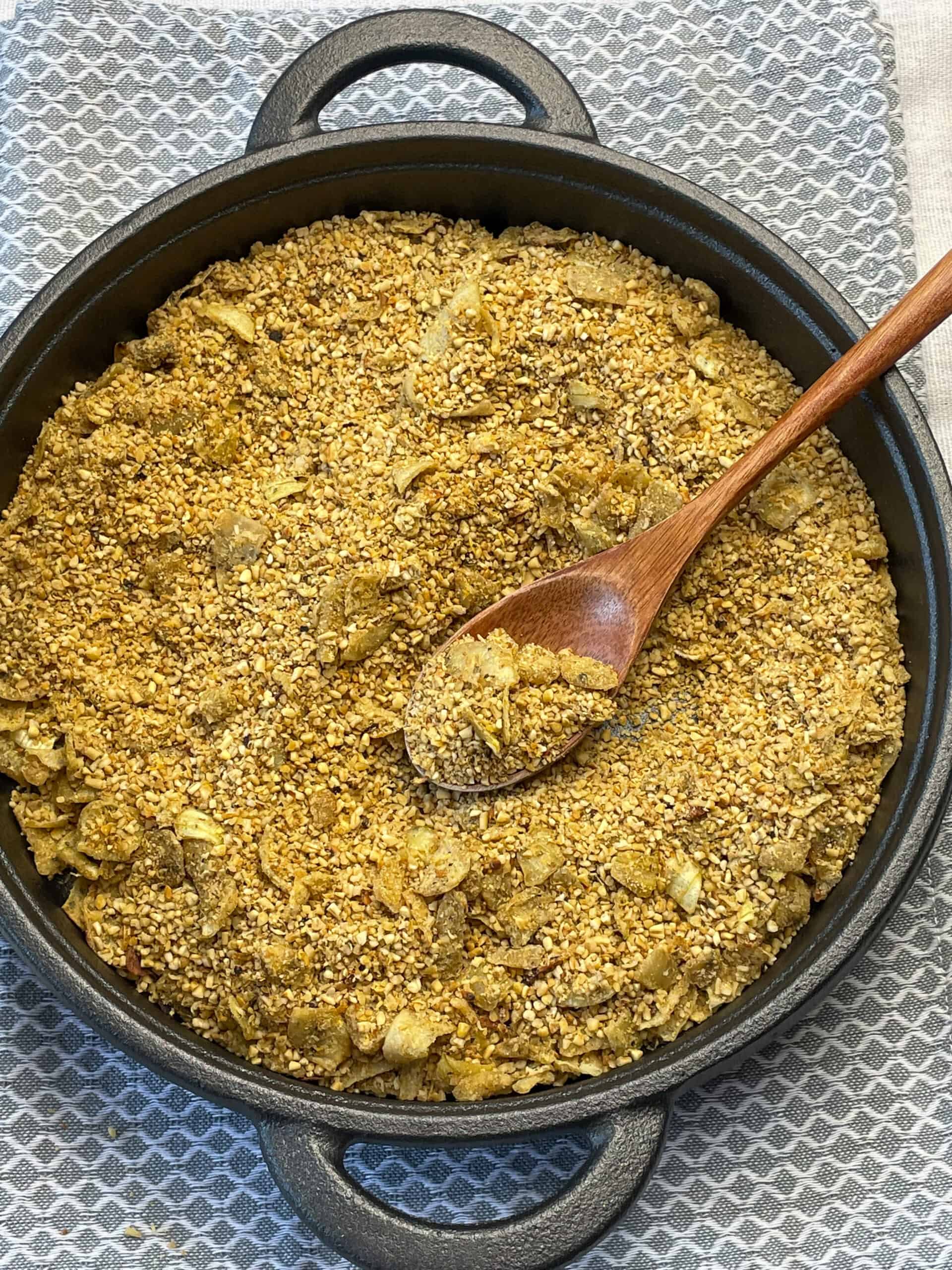
Our Vegan Scottish Skirlie recipe is very versatile and can be used as an easy vegan stuffing recipe, as well as a side-dish, garnish, snack, or as a budget-friendly vegan haggis alternative and enjoyed along with mashed neeps and tatties. You can either prepare this skirlie as a no-oil skirlie or use vegan butter and oil as preferred.
Origins of Scottish Skirlie
Scots have been enjoying Skirlie or, Skirl-in-the-pan, for centuries as oats have long been a staple crop and food. At one point bags of oats were even used as payment of rent! Traditional Skirlie is made by cooking onions in beef dripping or animal suet before adding pinhead or medium oatmeal and toasting in the pan until crisp and golden.
Some say that skirlie gets its name from the noise that the oatmeal makes as it cooks in the fat and is stirred around, as the name skirl refers to a ''loud noise'' mainly referring to the high pitch sound that bagpipes make! Scottish folk would traditionally use a wooden spurtle to stir the Skirlie but a wooden spoon or a spatula does the job fine.
Skirlie was traditionally enjoyed as a weekend meal, particularly on a Saturday, and was dished up with potatoes and a glass of milk, but richer folk would have had the skirlie with a meat roast possibly on a Sunday.
Today, small pots or packages of pre-made skirlie can be found in most Scottish supermarkets as it is still a popular choice for many Scots. Although, they mainly contain animal ingredients so are not suitable for vegan, vegetarian, or plant-based diets. A few spoonfuls of skirlie along with the traditional Scottish meal of ''mince and tatties'' is still a popular dinner for many Scots.

Vegan Skirlie
Vegan Skirlie is adapted from traditional Skirlie and the main difference is that it omits the animal fat and replaces it with a vegetable oil, vegan butter, or for a no-oil option - vegetable stock or broth. The result is a skirlie that is much lower in saturated fats and cholesterol.
Our recipe details two easy methods of preparing Skirlie. Both are essentially the same but one uses oil and the other vegetable broth or stock to sauté the onions and toast the oatmeal. We have tried each way and both are equally delicious.
Nutritional yeast flakes and dried mixed herbs provide the simple delicious flavourings and a grinding of black peppercorns and a dash of salt provide the simple finishing touches.
We have a vegan version of Scottish Mince and Tatties that can be prepared in the slow cooker or stove-top and a spoonful or two of our vegan skirlie would be a tasty addition. Likewise, sprinkle some skirlie over any soup or stew to create the best vegan comfort food. Such as our - Vegan Scottish Stovies or our Vegan Scotch Broth or our meat-free adaptation of Scotland's National Soup - Cock-a-Leekie.

How to prepare vegan Scottish skirlie
For our Skirlie recipe the type of oats that you need is pinhead oatmeal or commonly known in the US as steel cut oats, or in Scotland - medium oatmeal. If enjoying skirlie as the main component of a meal do serve it with a nice gravy or sauce.
You can prepare our skirlie recipe with your choice of oil or vegan butter but if you're on an oil-free diet it can be prepared with a small amount of vegetable stock or broth instead. We have tried both ways with great success.
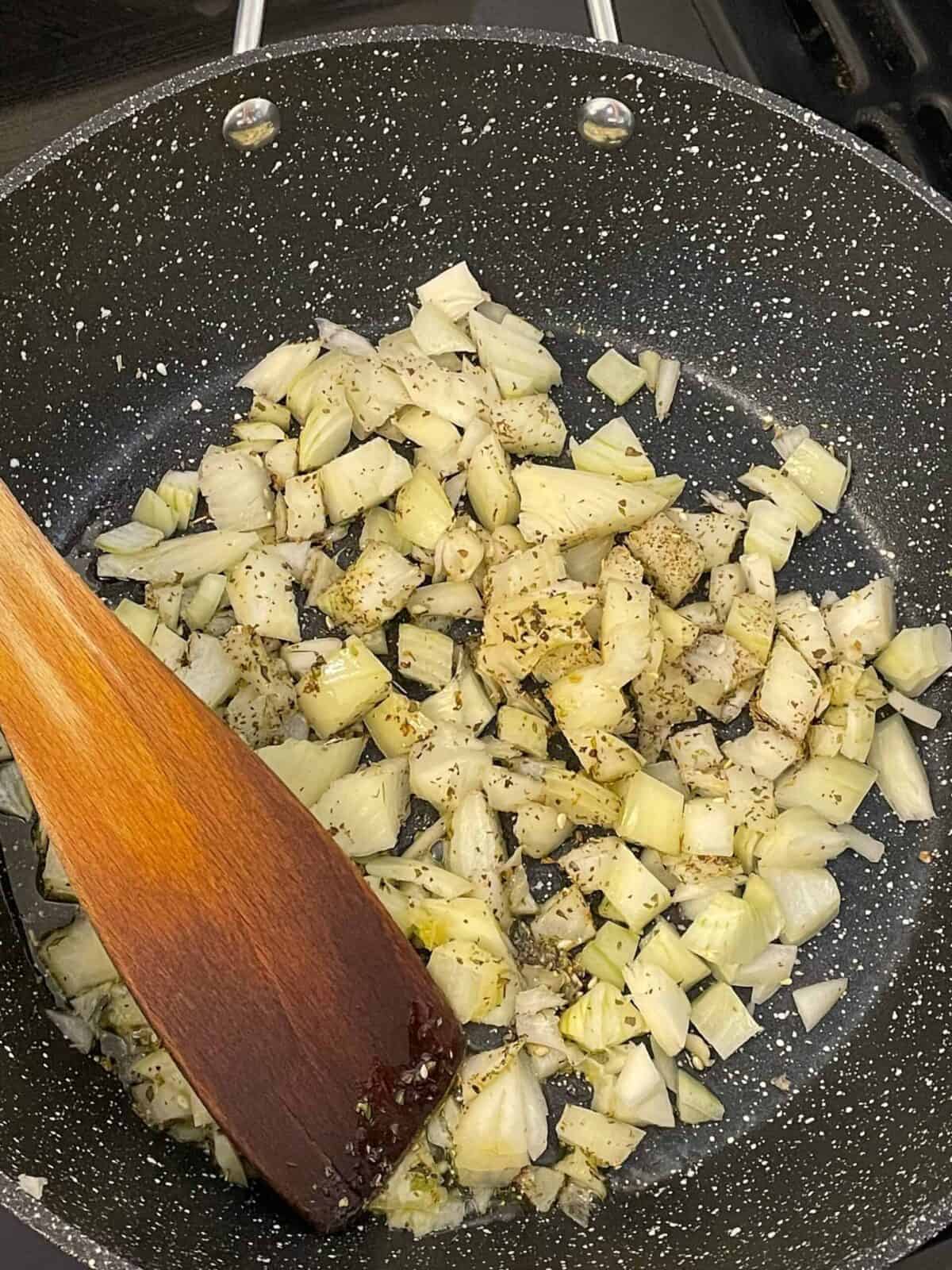
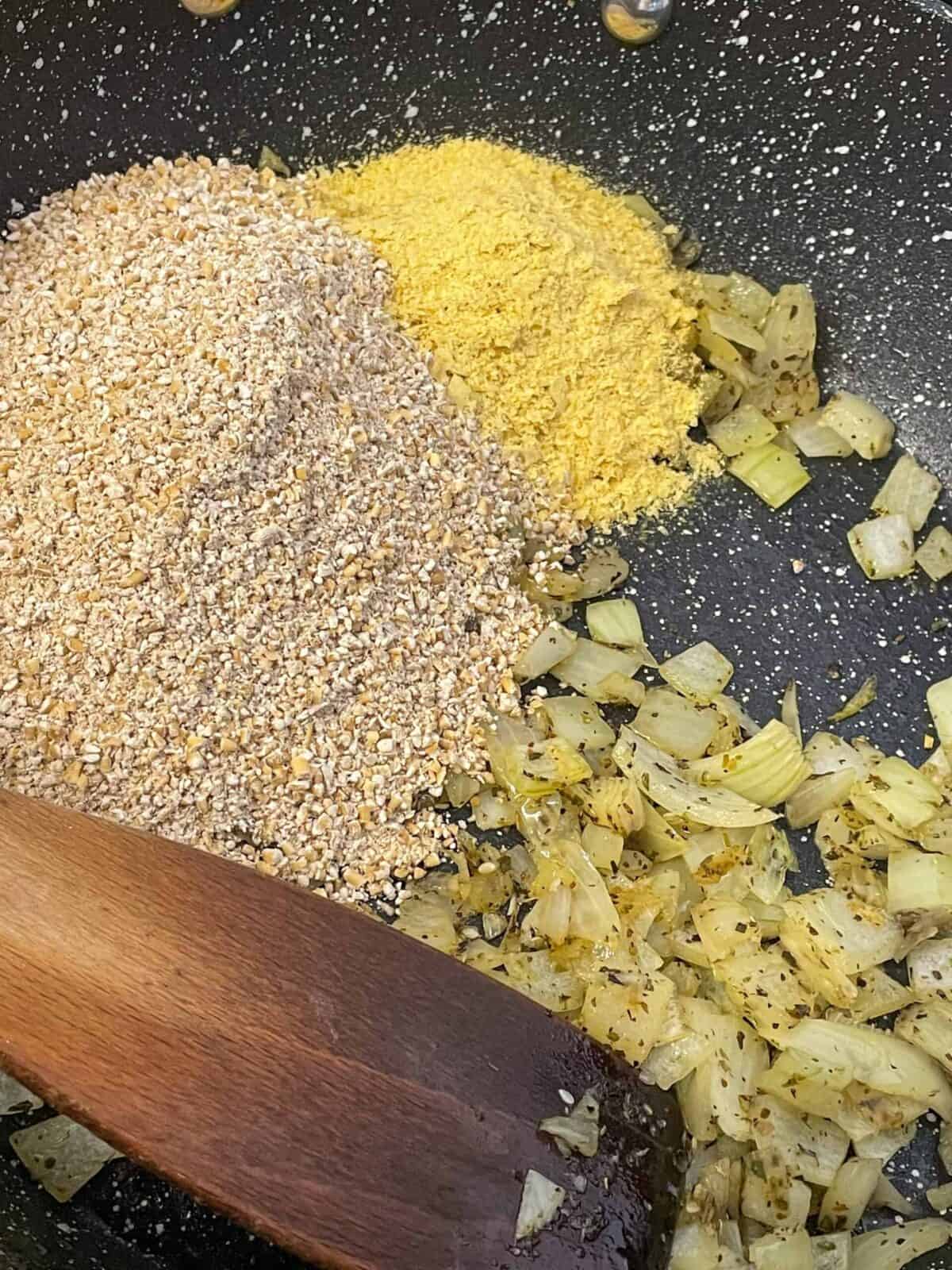
Sauté the onions and herbs in vegetable stock or oil until soft.
Mix through the oatmeal and nutritional yeast flakes.
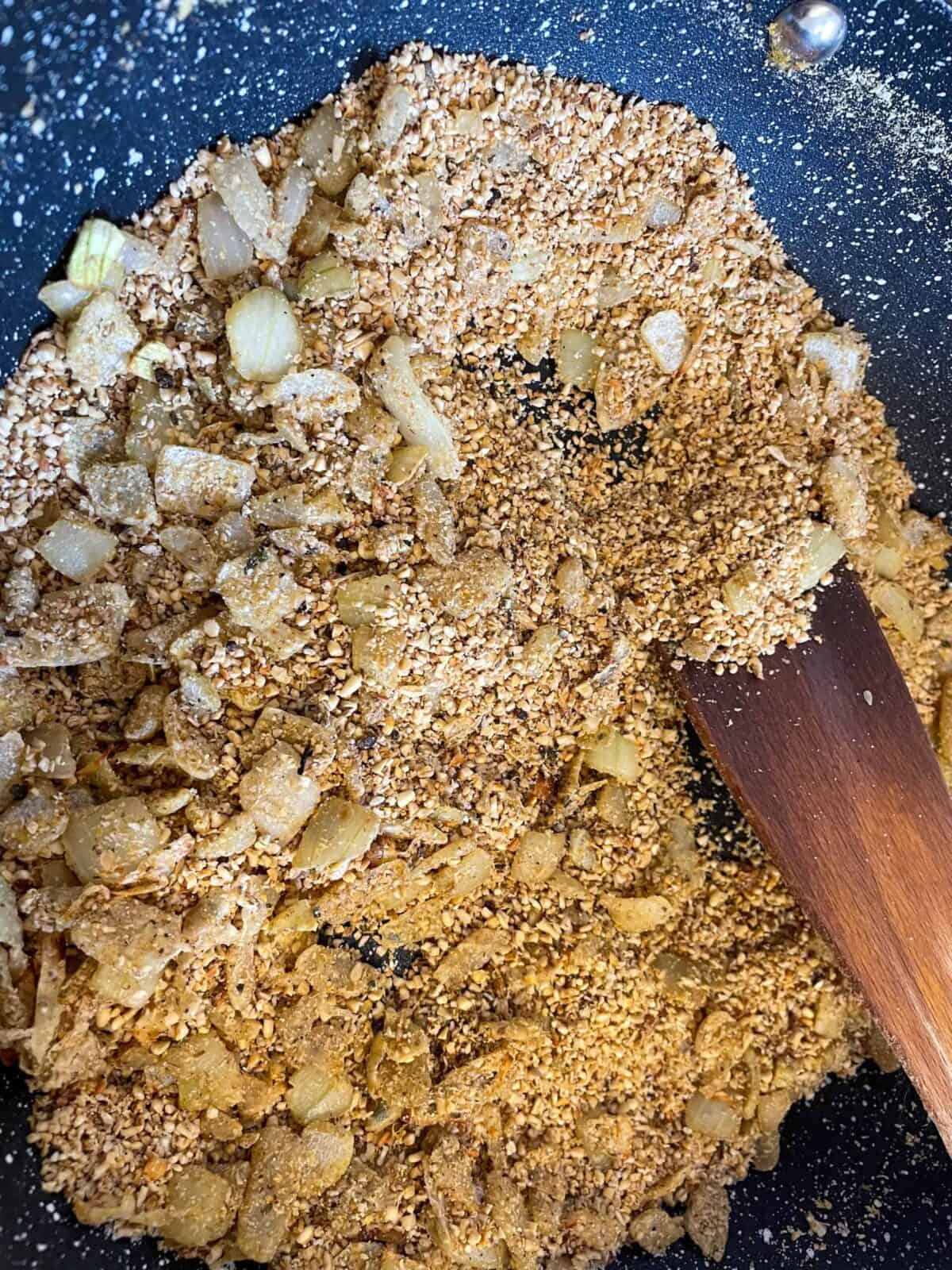
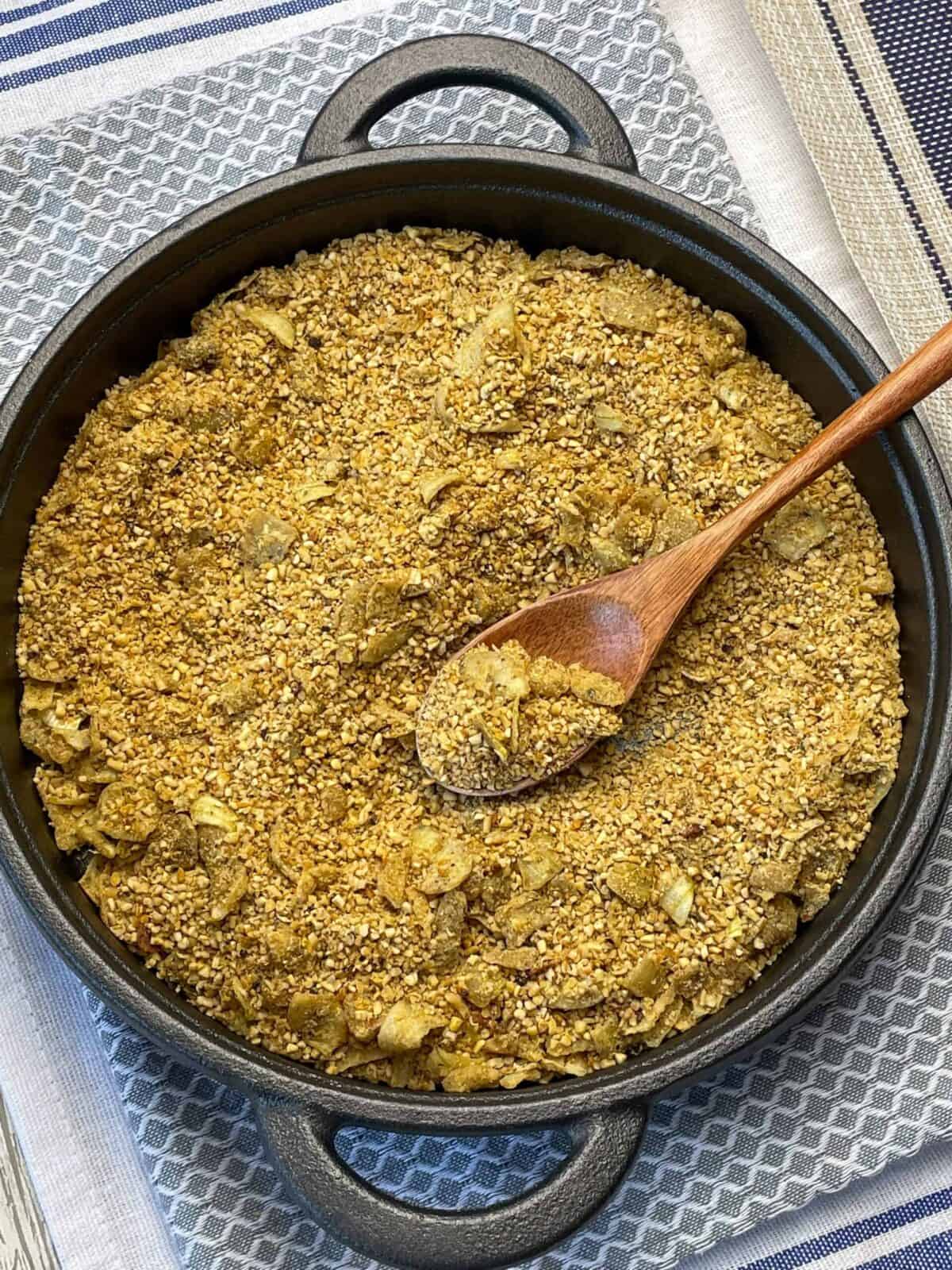
Toast and stir until the oatmeal is golden and crispy.
Season with plenty of black pepper and salt.
If you prefer a moister skirlie you can mix through a little hot vegetable broth or stock.
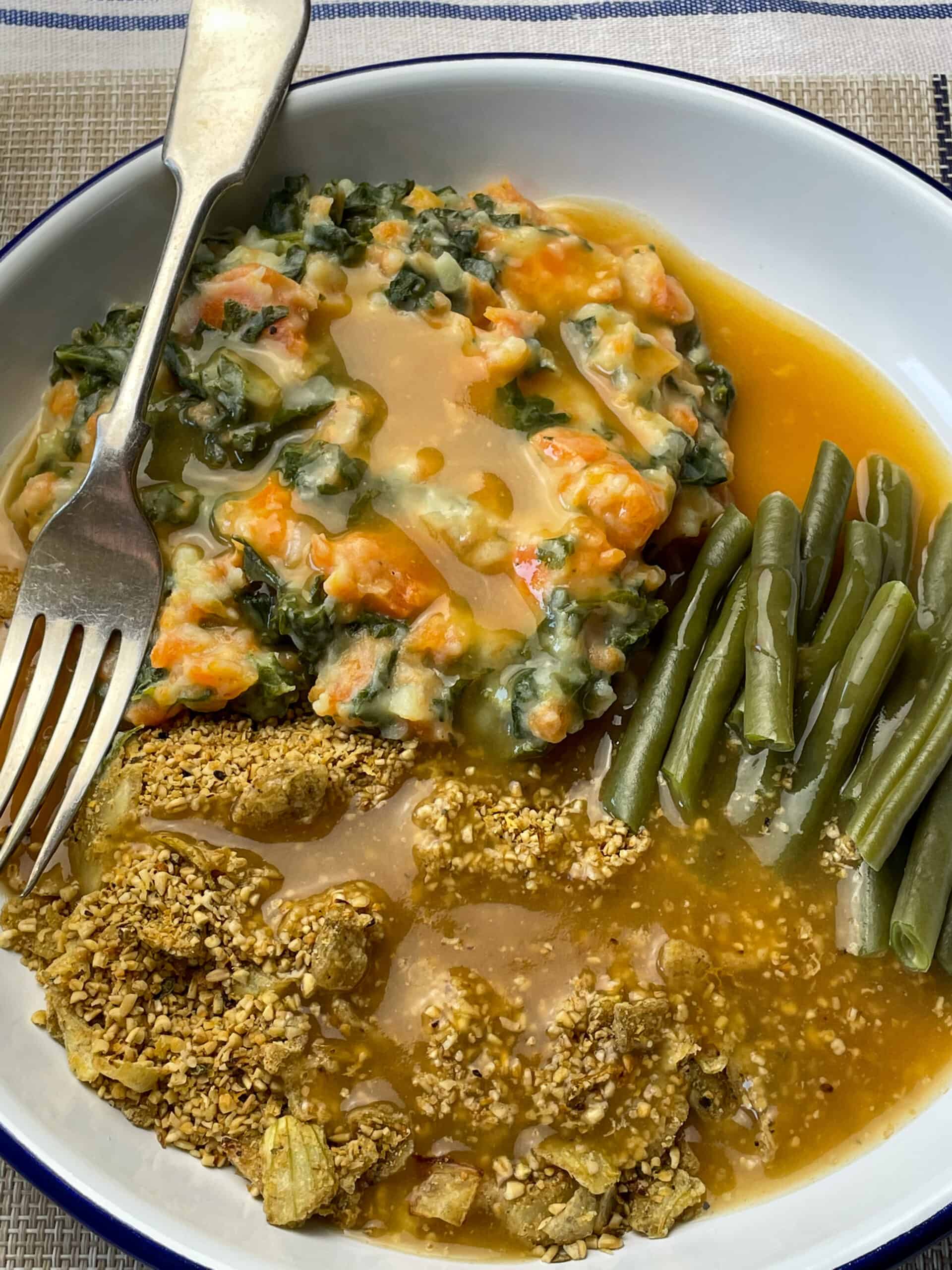
We like to have our skirlie with green beans and champ - which is a tasty old-fashioned mash of potatoes, white cabbage, & turnip [also known as swede or rutabaga], and lots of gravy.
Skirlie is also a delicious vegan oatmeal side dish to enjoy along side any of your favourite Scottish soups and stews. Pure homely vegan Scottish comfort food at its best!
Recipe notes and FAQ's
Storing
Skirlie can be stored within the refrigerator in a covered container for 3 days, possibly a day or two longer. Or freeze for 2-3 months, well wrapped in an air-tight freezer container.
Reheating
Skirlie can be added to a non-stick pan or skillet, and dry fried until nice and hot, or heat up a small amount of oil, vegan butter, or vegetable stock and then add the skirlie. Stir and reheat until piping hot.
Although, it is not necessary to reheat the skirlie as its also very tasty to just eat a spoonful directly from the refrigerator whenever you feel a bit peckish!
If you can source certified gluten-free pinhead or steel-cut oatmeal, then Skirlie can be adapted for those on a gluten-free diet. However, it's worth noting that some individuals may still be sensitive to even gluten-free oats. For more detailed information on this topic, visit coeliac.org.uk. While oatmeal is inherently gluten-free, it can be problematic for many requiring gluten-free diets due to potential cross-contamination. This is because oatmeal is often processed in facilities that handle gluten-containing ingredients. Also, if you opt for the oil-free Skirlie version, ensure you use a gluten-free vegetable stock.
1. For a main component within a meal this recipe serves 4-6, depending on appetites, but for a side-dish or garnish the skirlie could be stretched to 6-8 portions.
2. Skirlie can be served as a topping for soups, stews, casseroles, pasta bakes, mac and cheese, vegetable gratins and hotpots.
3. Its particularly tasty as a main component in a simple and inexpensive meal with some veggie gravy and mashed potatoes.
4. Traditionally skirlie was used as a poultry stuffing. Skirlie can be used as a stuffing for tasty veggies. For example stuff little pumpkins, squashes, bell peppers, courgettes [zucchini], aubergines [eggplants], large mushrooms, or large tomatoes, with vegetables, grains, and your choice of sauce, and some vegan skirlie.
5. Or sprinkle the skirlie on top of your stuffed vegetable dish, mac and cheese, or as part of a savoury gratin, crisp or crumble topping, and toast in the oven or under a grill [broiler].
6. Sprinkle skirlie over a salad.
7. Have a scoop of skirlie along with a vegan cooked breakfast such as cooked tomatoes, mushrooms, potato scones, vegan bacon, baked beans, etc.
8. Add a sprinkling of skirlie to your favourite sandwich or wrap filling.
9. Or simply enjoy a spoonful of cold skirlie straight from the refrigerator as a tasty, fortifying snack. Which is what we like to do paired with a glass of oat milk.
For skirlie, the best oats to use are pinhead oatmeal, also known as steel-cut oats or Irish oatmeal, or medium oatmeal in Scotland, as those were the types of oats used for traditional skirlie.
Pinhead oatmeal is coarser than rolled, porridge, or instant oats, providing the grainy texture required for skirlie. Also as pinhead oatmeal is less processed they have a better flavour as they are more nuttier and earthier compared to rolled oats.
Yes, you can use porridge oats, also known as rolled oats,to make Skirlie, but seeing as they are not the traditional type of oats for skirlie there are some considerations to keep in mind.
Porridge oats or rolled oats are flatter and softer than pinhead oatmeal or steel-cut oats because they have been steamed and then rolled. As a result, Skirlie made with porridge oats will have a softer texture and may not have the same grainy consistency that pinhead oatmeal has.
Also, rolled oats cook faster than steel-cut oats so you may need to adjust the cooking time to ensure you don't overcook the Skirlie or turn it into a mushy consistency. The taste will likely change as the nuttier and earthier flavour of steel-cut oats will be much less if rolled oats are used.
Although, to compensate for the differences between the oats perhaps pre-toast the porridge oats first as this will firm them up before proceeding with the recipe.
However, do keep in mind that we have not tested this recipe with porridge or rolled oats, but if you do then we would love to know how you got on!
Skirlie is referred to as a 'poor man's haggis' because in the past meat was a very expensive ingredient and the poorer Scottish folks would not have easy access to meat nor would it have been an every day food. Many Scots only ate meat a few times a year as it was considered a luxury.
Instead ingredients such as potatoes and oats were consumed every day so preparing a meat-free skirlie dish that could be eaten as a haggis replacement just made sense!
Also, skirlie only required a few other ingredients which was mainly an animal fat such as suet or dripping, and an onion if it was available. Whereas haggis required much more ingredients as well as a longer cooking time compared to skirlie.
A serving of vegan Scottish skirlie not only enhances your dishes with tasty savoury flavours and textures but it also provides a nutritional boost. It's an excellent way to satisfy hunger pangs, particularly useful considering some vegan and plant-based dishes might be lower in calories. I
've found that incorporating oatmeal into meals, like Skirlie, can be especially helpful for bigger appetites - such as my teenage son as an example, it keeps him fuller for longer!
Oats are packed with plant-based nutrition. A single serving of our skirlie recipe can offer around 3mg of iron, 7g of fibre, and 9g of protein. However, please note these aren't precise figures as nutritional values can vary based on computerized calculations and ingredient differences.

Our Skirlie recipe is perfect for vegan Robert Burns Suppers, or vegan Hogmanay meals, or even vegan St Andrew's Day feasts. Its also a wholesome staple recipe to add to your regular meal rotation as its incredibly budget-friendly and versatile so you can add it to any dish for an instant flavour or nutrition boost. I particularly love a cheeky spoonful straight from the refrigerator for a late night snack, whenever I'm feeling peckish but its too late to make anything!
More vegan traditional Scottish recipes
As a Scottish family many traditional Scottish foods are very familiar to us as we grew up with our families cooking similar recipes or buying them ready-made from the shops!
Although, as I turned vegetarian during my primary school years it was quite difficult as meat does play a central role in Scottish food so veggie options were very limited.
The veggie option was mainly the sides of the meat dish, such as potatoes and a few carrots, or a case of picking out the meat from the served meal!
However, these days I find much joy in adapting the old traditional family favourites into delicious vegan, vegetarian, & plant-based versions and sharing these recipes, meals, and bakes with my family and with You, my very welcomed visitors!
And I extend that welcome to everyone regardless of their main diet - as the main thing is to just Eat More Plants!
For more meat-free Scottish recipes do check out our growing collection of Vegan Scottish Recipes.
***please note: for US measurements click the 'US customary button' within the recipe and the measurements will switch to tablespoons, cups, and ounces.***
📖 Recipe

Vegan Scottish Skirlie
Equipment
- Non stick skillet or fry pan.
Ingredients
- 200 grams pinhead oatmeal [also known as steel-cut oatmeal, or medium oatmeal in Scotland]
- 1 large onion [diced]
- 4 teaspoons nutritional yeast flakes [use more if preferred]
- 1 teaspoon dried mixed herbs [or dried thyme or fresh thyme leaves]
- 3 tablespoon olive oil [or your usual oil, vegan butter]
Optional:
- 2 tablespoons vegan butter
Only required if preparing an oil-free skirlie:
- 240 mililitres vegetable stock [or broth, use a little more if necessary]]
Instructions
Oil method:
- Heat 2 tablespoons of oil or butter over a medium heat.3 tablespoon olive oil
- Add the onion and dried mixed herbs. Sauté the onion and dried mixed herbs for 10 minutes or until nice and soft. Stir occasionally.1 large onion, 1 teaspoon dried mixed herbs
- Add another 1 tablespoon of oil and when the oil is hot, add the oatmeal and nutritional yeast flakes, and stir well.200 grams pinhead oatmeal, 4 teaspoons nutritional yeast flakes
- Over a medium heat cook and stir frequently for 10-15 minutes until the oatmeal is toasted golden and crisp. Be careful not to let the oatmeal sit in one spot for too long as it may brown too much.
- Remove the pan from the heat and check the seasoning. Add plenty of black pepper and enough salt to taste.
- Optional: Dot two tablespoons of vegan butter over the cooked and seasoned skirlie in the pan and it will melt through the skirlie.2 tablespoons vegan butter
Oil-free method:
- Pour the vegetable stock into the pan and bring to a simmer over a medium heat.Mix through the onion and dried herbs.1 large onion, 240 mililitres vegetable stock, 1 teaspoon dried mixed herbs
- Lower the heat and simmer for about 10 minutes until the onion is soft and stock has nearly evaporated. If the veggie stock dries up too quick add a few extra tablespoons. Give it an occasionally stir.
- Add the oatmeal and nutritional yeast flakes and mix thoroughly.200 grams pinhead oatmeal, 4 teaspoons nutritional yeast flakes
- Over a medium heat, toast the oatmeal for around 10-15 minutes until it is golden brown and crisp.While toasting you need to frequently stir the oatmeal around to avoid browning too much and to evenly toast.
- Remove the pan from the heat and check the seasoning and add enough black pepper and salt to taste. Extra nutritional yeast flakes can be stirred through if liked.
Notes
- Nutritional information is provided for guidance only and is not a strict calculation as ingredients vary. Data is for the skirlie cooked in 3 tablespoons of oil and does not include the optional vegan butter garnish.
- Data for the oil-free skirlie is: 220 kcal, 1 g saturated fat, 2g sugar, 2mg Iron, 38g Carbs, 242mg sodium, 137IU vitamin A, 9g protein, 4g fat, 7g fiber, 42mg calcium.
- Skirlie can be stored in the fridge for up to 3 days in a covered container.
- To reheat - place the skirlie back in the pan and over a medium heat, stir frequently until heated through. A small amount of oil of vegetable stock can be heated first before adding the skirlie to reheat.
- Skirlie can be frozen for up to 2-3 months.
- Skirlie can be enjoyed chilled straight from the fridge as a quick snack.
- Use skirlie as a side dish along with other veggies, grains, pulse, etc.
- Or use as a haggis replacement, and serve with mashed potatoes, mashed turnip, and lots of gravy. Or serve alongside a tasty veggie haggis!
- Skirlie can also be sprinkled over salad, soups, or stews for an instant flavour and nutrition boost.
- Also tasty sprinkled over hotpots, mac and cheese, and as part of a veggie gratin topping.
- Or use as part of a stuffing for bell peppers, mushrooms, courgettes, tomatoes, acorn or butternut squash.
Nutrition
Prepared our Vegan Scottish Skirlie? We would love to know how you got on with the recipe especially if you prepared either the oil version or the oil-free recipe? Do pop a comment below and click the star ratings. Its very much appreciated!
Would you like to see a particular traditional Scottish meal adapted into a vegan and plant-based recipe? Drop us a comment below and let us know and we will do our best. Thanks! All the best, Jacq x


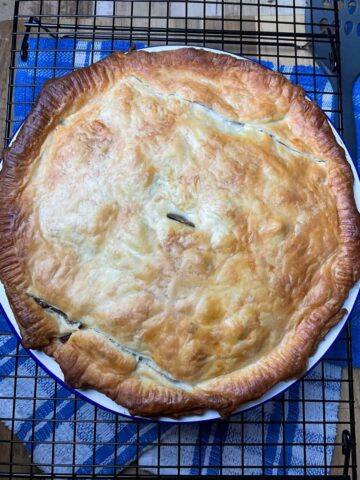

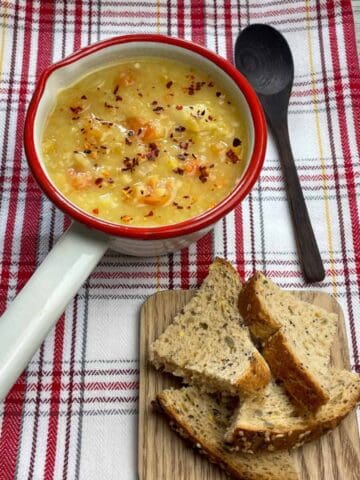

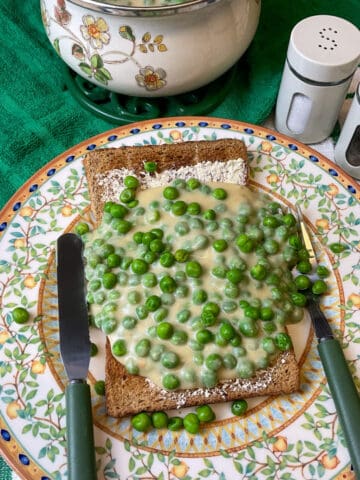
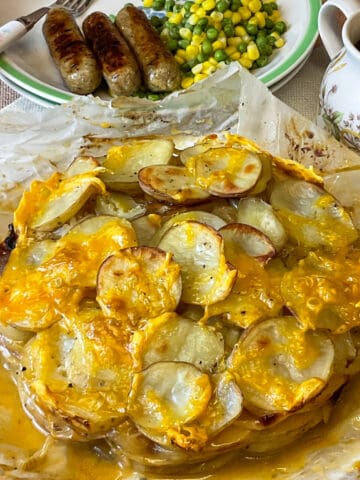
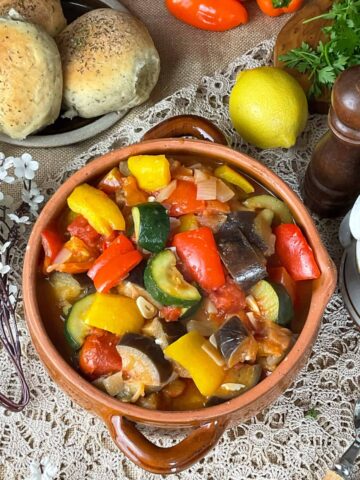
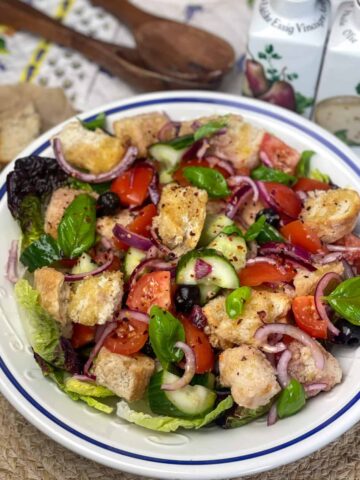
Rosemary
I'm not familiar with Scottish cooking so this was quite fascinating. I do love the idea of cooking with nutritional yeast. It sounds great and I'm quite intrigued!
Jacq
The nutritional yeast is amazing in this recipe it just adds a subtle savoury yumminess. So glad you enjoyed my post 🙂
Beth
I haven't heard about this recipe, but it looks so tasty and delicious! The family is going to be all over this recipe! Excited to make this soon!
Jacq
Thanks so much. The Skirlie will have you at just one bite! Pour gravy over and its just fab. Perfect as a Christmas side-dish 🙂
Carrie Robinson
I have never heard of this dish before, but it sounds delicious! 🙂
Jacq
Most people have not heard of Skirlie even some Scots! But its such an easy, tasty, nutritious and budget-friendly addition to anyone's diet that I just had to share it 🙂
Lima Ekram
This looks amazing - I love the idea of using nutritional yeast!
Jacq
The nutritional yeast is awesome in this recipe, so worth the addition 🙂
Sharmila Kingsly
This is new to me and I love the idea. going to make a big batch on the weekends and I believe it helps in my meal preps!!
Jacq
Absolutely helps with your meal preps! Any leftovers can be frozen until needed, and it quickly defrosts 🙂
Gina
This is a totally new dish to me but I had all the ingredients on hand and it was delicious! Savory oatmeal is underrated!
Jacq
Absolutely underrated! Savoury oatmeal is becoming popular but us Scots have been enjoying it for hundreds of years. So glad you enjoyed the Skirlie 🙂
Lillie
I have been wanting to try a savory oatmeal-based dish, so this is perfect. Thanks!
Jacq
Awesome! Happy cooking! x
Biana
What a great idea! I like making stuffed peppers and tomatoes, and this recipe should be perfect for that.
Jacq
Thanks so much! Would love to hear how you get on. x
Soheila
I love seeing how people take traditional dishes like this one and make them vegan friendly. Thanks for the inspiration!
Jacq
Aww thanks so much. Its what I love to do. So glad you liked my dish. x
Denise Macuk
This sounds delicious, I love grains and nutritional yeast!
Jacq
Great! Me too! x
Carrie Ann | The Leafy Little Home
I love this vegan version of skirlie! That's a great idea to use it to stuff vegetables and top with vegan cheese sauce—so yummy!
Jacq
Aww thanks for your comment. Glad you like my recipe. I love this Skirlie though I need to stop myself from eating a spoonful each time I pass my fridge!